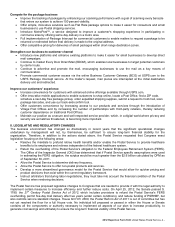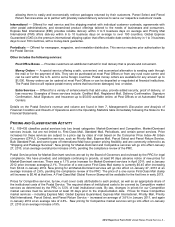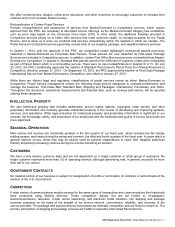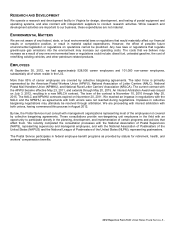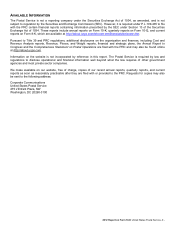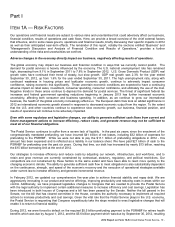US Postal Service 2012 Annual Report Download - page 15
Download and view the complete annual report
Please find page 15 of the 2012 US Postal Service annual report below. You can navigate through the pages in the report by either clicking on the pages listed below, or by using the keyword search tool below to find specific information within the annual report.2012 Report on Form 10-K United States Postal Service- 14 -
Our operational and administrative information systems are among the largest and most complex systems maintained by
any organization in the world. Any disruption to our complex infrastructure, including those impacting the computer
systems which facilitate mail handling and delivery, and customer utilized websites, could adversely impact customer
service, mail volumes, and revenues, and result in significant increased cost. Any significant systems failure could cause
delays in the processing and delivering of mail or result in the inability to process operational and financial data. System
failures such as this could damage our reputation, resulting in loss of business and increased costs.
Due to our current cash constraints, our operational performance in the future could be at risk as a result of
inadequate capital investment in transportation equipment, mail processing equipment, facilities, or information
technology which are either essential to operations or to improve the quality of our services.
Failure to anticipate or react to our competition, market demands, and/or new technology due to inadequate cash
reserves is a significant operational risk. Our aging facilities, equipment, and transportation fleet could inhibit our ability to
be competitive in the marketplace, deliver a high-quality service, and meet the communication needs of the American
public. The changes in the economic landscape in recent years have made it increasingly important for the Postal Service
to invest in its operations in order to remain competitive. If our operations do not generate the liquidity we require, we may
be forced to reduce, delay, or cancel investments in technology, facilities, and/or transportation equipment while our direct
competitors and other businesses are pursuing advanced, competing technologies and equipment. Aging or potentially
obsolete infrastructure could result in a loss of business and increased costs.
We have a substantial amount of indebtedness.
As of September 30, 2012, we had reached the statutory $15 billion debt limit. Our significant indebtedness to the Federal
Financing Bank has important consequences. For example, it limits our flexibility in planning for, or reacting to changes in
our organization; it places us at a competitive disadvantage compared to commercial competitors that may have less debt
and which have access to the public capital markets; and it could require us to dedicate a substantial portion of our cash
flow from operations to payments on indebtedness, thus reducing the availability of cash flow to fund working capital,
capital expenditures, and other general organizational activities.
Health and pension benefit costs represent a significant expense to us.
With approximately 528,000 career employees and 471,000 annuitants and survivors participating in the Federal
Employees Health Benefit Plan, our expenses relating to employee and retiree health and pension benefits are significant.
We participate in federal government pension and health and benefits programs for employees and retirees, including the
Federal Employees Health Benefit (FEHB) Program, the Civil Service Retirement System (CSRS), and the Federal
Employees Retirement System (FERS). We have no control or influence over the benefits offered by these plans and
make contributions to these plans as specified by law or contractual agreements with our unions (in the case of health
benefits for most active employees). Several factors could cause us to make significantly higher future contributions to
these plans; and many of these factors are beyond Postal management’s control.
In addition, P.L. 111-148, the Patient Protection and Affordable Care Act, was passed in 2010. Because final regulations
have not yet been approved, the future impact on our financial condition, results of operations, or liquidity remains
unknown.
In recent years, we have experienced significant increases in retiree health benefits costs, primarily as a result of the
Postal Accountability and Enhancement Act, (P.L. 109-435), which obligates us to fully fund the established health
benefits of current retirees and current postal employees who have not yet retired in an accelerated time frame.
Additionally, we are required to continue contributing to the FERS pension program at OPM-specified rates, and may be
required to contribute to the CSRS, beginning in 2017, if OPM determines that a supplemental unfunded liability payment
is necessary.
At this time, we are unable to determine the amount of additional future contributions, if any, or whether any material
adverse effect on our financial condition, results of operations, or liquidity could result from our participation in these
plans.
Workers’ compensation insurance and claims expenses could have a material adverse effect on our business,
financial condition, and results of operations.
Workers’ compensation accruals are established for estimates of the expense that we will ultimately incur on reported
claims, as well as estimates of claims that have been incurred but not yet reported. Trends in actual experience and


